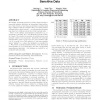Free Online Productivity Tools
i2Speak
i2Symbol
i2OCR
iTex2Img
iWeb2Print
iWeb2Shot
i2Type
iPdf2Split
iPdf2Merge
i2Bopomofo
i2Arabic
i2Style
i2Image
i2PDF
iLatex2Rtf
Sci2ools
SIGMOD
2008
ACM
2008
ACM
Preservation of proximity privacy in publishing numerical sensitive data
We identify proximity breach as a privacy threat specific to numerical sensitive attributes in anonymized data publication. Such breach occurs when an adversary concludes with high confidence that the sensitive value of a victim individual must fall in a short interval -- even though the adversary may have low confidence about the victim's actual value. None of the existing anonymization principles (e.g., kanonymity, l-diversity, etc.) can effectively prevent proximity breach. We remedy the problem by introducing a novel principle called (, m)-anonymity. Intuitively, the principle demands that, given a QI-group G, for every sensitive value x in G, at most 1/m of the tuples in G can have sensitive values "similar" to x, where the similarity is controlled by . We provide a careful analytical study of the theoretical characteristics of (, m)-anonymity, and the corresponding generalization algorithm. Our findings are verified by experiments with real data. ACM Categories an...
| Added | 08 Dec 2009 |
| Updated | 08 Dec 2009 |
| Type | Conference |
| Year | 2008 |
| Where | SIGMOD |
| Authors | Jiexing Li, Yufei Tao, Xiaokui Xiao |
Comments (0)

